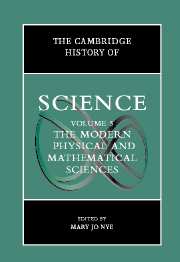Book contents
- Frontmatter
- Introduction: The Modern Physical and Mathematical Sciences
- Part I The Public Cultures of the Physical Sciences After 1800
- 1 Theories of Scientific Method
- 2 Intersections of Physical Science and Western Religion in the Nineteenth and Twentieth Centuries
- 3 A Twisted Tale: Women in the Physical Sciences in the Nineteenth and Twentieth Centuries
- 4 Scientists and Their Publics: Popularization of Science in the Nineteenth Century
- 5 Literature and the Modern Physical Sciences
- Part II Discipline Building in the Sciences: Places, Instruments, Communication
- Part III Chemistry and Physics: Problems Through the Early 1900s
- Part IV Atomic and Molecular Sciences in the Twentieth Century
- Part V Mathematics, Astronomy, and Cosmology Since the Eighteenth Century
- Part VI Problems and Promises at the End of the Twentieth Century
- Index
- References
3 - A Twisted Tale: Women in the Physical Sciences in the Nineteenth and Twentieth Centuries
from Part I - The Public Cultures of the Physical Sciences After 1800
Published online by Cambridge University Press: 28 March 2008
- Frontmatter
- Introduction: The Modern Physical and Mathematical Sciences
- Part I The Public Cultures of the Physical Sciences After 1800
- 1 Theories of Scientific Method
- 2 Intersections of Physical Science and Western Religion in the Nineteenth and Twentieth Centuries
- 3 A Twisted Tale: Women in the Physical Sciences in the Nineteenth and Twentieth Centuries
- 4 Scientists and Their Publics: Popularization of Science in the Nineteenth Century
- 5 Literature and the Modern Physical Sciences
- Part II Discipline Building in the Sciences: Places, Instruments, Communication
- Part III Chemistry and Physics: Problems Through the Early 1900s
- Part IV Atomic and Molecular Sciences in the Twentieth Century
- Part V Mathematics, Astronomy, and Cosmology Since the Eighteenth Century
- Part VI Problems and Promises at the End of the Twentieth Century
- Index
- References
Summary
Dismissed as inconsequential before the 1970s, the history of the contributions of women to the physical sciences has become a topic of considerable research in the last two decades. Best known of the women physical scientists are the three “great exceptions” from central Europe – Sonya Kovalevsky, Marie Sklodowska Curie, and Lise Meitner– but in recent years, other women and other countries and areas have been receiving attention, and more is to be expected in the future. The overall pattern for most women in these fields, the nonexceptions, has been one of ghettoization and subsequent attempts to overcome barriers.
PRECEDENTS
Before 1800 there were several self-taught and privately-tutored “learned ladies” in the physical sciences. Included were the English self-styled “natural philosopher” Margaret Cavendish (1623–1673), who wrote books and in the 1660s visited the Royal Society of London, which had not elected her to membership; the German astronomer Maria Winkelmann Kirch (1670– 1720), who worked for the then-new Berlin Academy of Sciences in the early 1700s; the Frenchwoman Emilie du Chatelet (1706–1749), who translated Newton’s Principia into French before her premature death in childbirth in 1749; the Italians Laura Bassi (1711–1778), famed professor of physics at the University of Bologna, and Maria Agnesi (1718–1799), a mathematician in Bologna; Ekaterina Romanovna Dashkova (1743–1810), the director of the Imperial Academy of Sciences in Russia; and Marie Anne Lavoisier (1758– 1836), who helped her husband Antoine with his work in the Chemical Revolution.
- Type
- Chapter
- Information
- The Cambridge History of Science , pp. 54 - 71Publisher: Cambridge University PressPrint publication year: 2002
References
- 1
- Cited by

